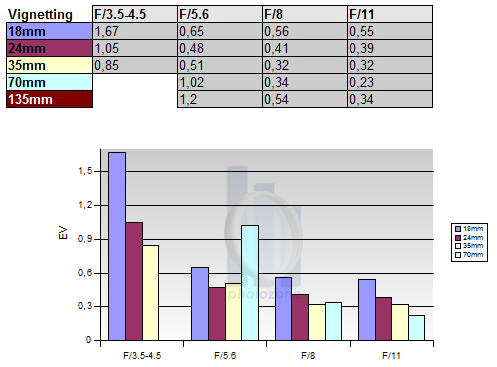|
Canon EF-S 18-135mm f/3.5-5.6 IS - Review / Lab Test Report - Analysis |
|
Lens Reviews -
Canon EOS (APS-C)
|
|
Page 2 of 2

Distortion
Typical for many "super" zoom lenses the Canon exhibits an extreme amount of barrel distortion at 18mm (~4.2%). The problem is substantially reduced at 24mm (~0.7%) and beyond there is only moderate pincushion distortion around ~1%.
|
Move the mouse cursor over the focal length text marks below to observe the respective distortion
|
| 18mm |
24mm |
35mm |
70mm |
135mm |

|
The chart above has a real-world size of about 120x80cm.
Vignetting
It's fairly common for dedicated APS-C lenses to show a more pronounced vignetting at max. aperture settings. The Canon lens is no exception here especially at 18mm with a rather extreme peak vignetting of 1.67 f-stops at 18mm @ f/3.5. At 70mm and 135mm @ f/5.6 it's also somewhat hefty at 1EV and 1.2EV respectively. The situation isn't as bad at other settings but usually you should generally stop down a bit to avoid the problem.

MTF (resolution)
The resolution characteristic of the EF-S 18-135mm IS is not exactly promising especially at large aperture settings. The center resolution is generally a non-issue and very high at all tested settings. However, the border quality is a different story. At 18mm you should avoid the f/3.5 setting due to very pronounced corner softness. The situation improves significantly when stopping down to f/5.6 or f/8 - the center to corner performance is actually pretty good here. The sweet spot of the lens is reached at 35mm with very good figures across the image field. The border quality is very poor at 70mm and 135mm again. It improves at f/8 and f/11 but the corner quality remains rather unimpressive.
Please note that the MTF results are not directly comparable across the different systems!
Below is a simplified summary of the formal findings. The chart shows line widths per picture height (LW/PH) which can be taken as a measure for sharpness.
If you want to know more about the MTF50 figures you may check out the corresponding Imatest Explanations
Chromatic Aberrations (CAs)
The level of lateral CAs (color shadows at harsh contrast transitions) is quite well controlled for such a lens. The problem is most obvious at 18mm with an average CA pixel width of 1.2-1.5px at the borders - the amount of lateral CAs increase significantly in the extreme corners though (2+px). At other focal lengths and aperture settings it's slightly lower at around 1px.

Verdict
The Canon EF-S 18-135mm f/3.5-5.6 IS may be somewhat better than the EF-S 18-200mm f/3.5-5.6 IS but it's not exactly a good lens either. The resolution makes a rather wild roller coaster ride through the different quality levels. Large aperture settings should be generally avoided at 18mm and beyond the middle range - the borders/corners are plain soft here. However, to be fair the lens is actually quite usable at f/8 (18mm) and f/11 (70mm+). It's also a good idea to stop down a little in order to overcome the rather heavy vignetting problems at max. aperture. Lateral CAs are somewhat more obvious at 18mm, especially in the corners, but this is a general problem in this lens class. The level of barrel distortions is extreme at 18mm, less so at other focal lengths.
There's little to complain about the build quality which is about average, no more and no less. The AF is pretty fast despite relying on a conventional DC motor rather than USM. This applies to phase-detection AF mode - it's much worse (slow) in LiveView (contrast AF). All-in-all it's not one of the more desirable lenses on the market and it's really surprising to see that this lens is bundled with the EOS 7D which is even more demanding in terms of required lens quality than the EOS 50D used for this test.
|